
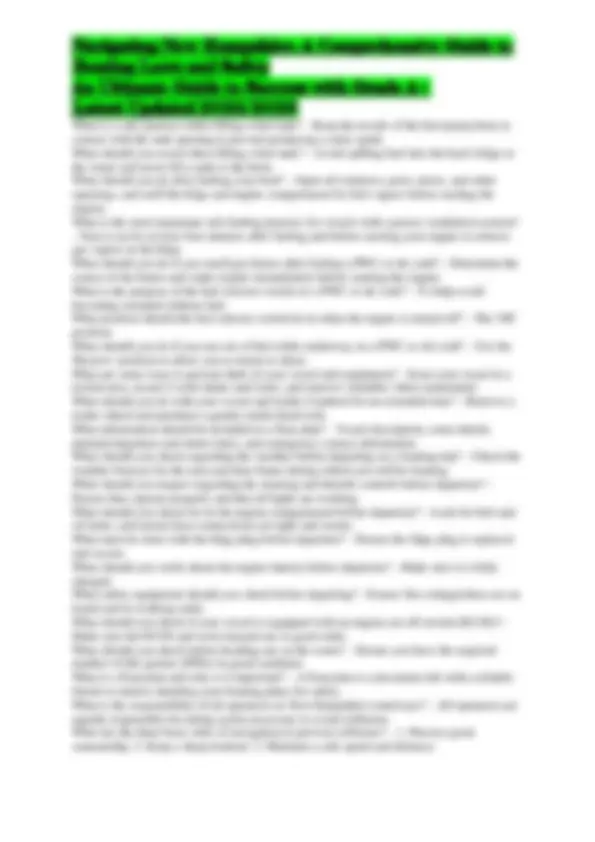
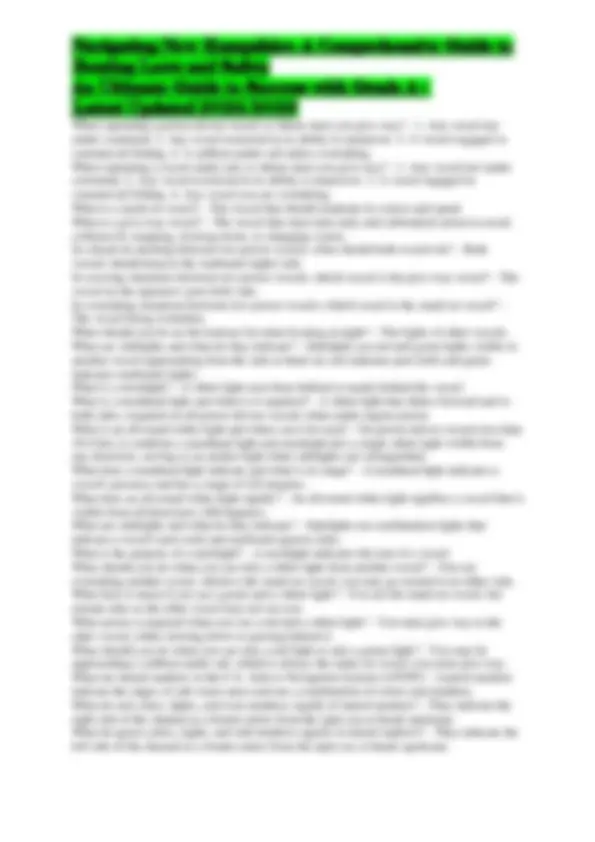
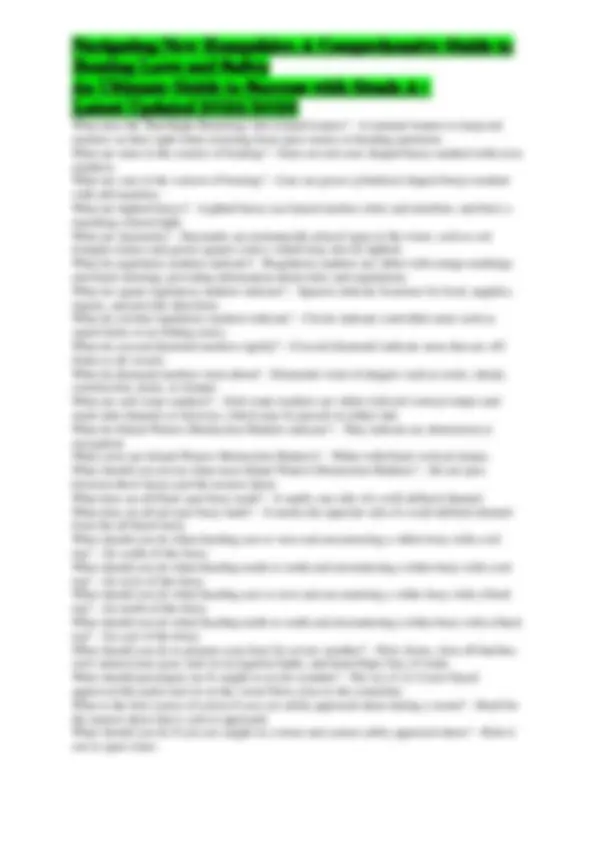
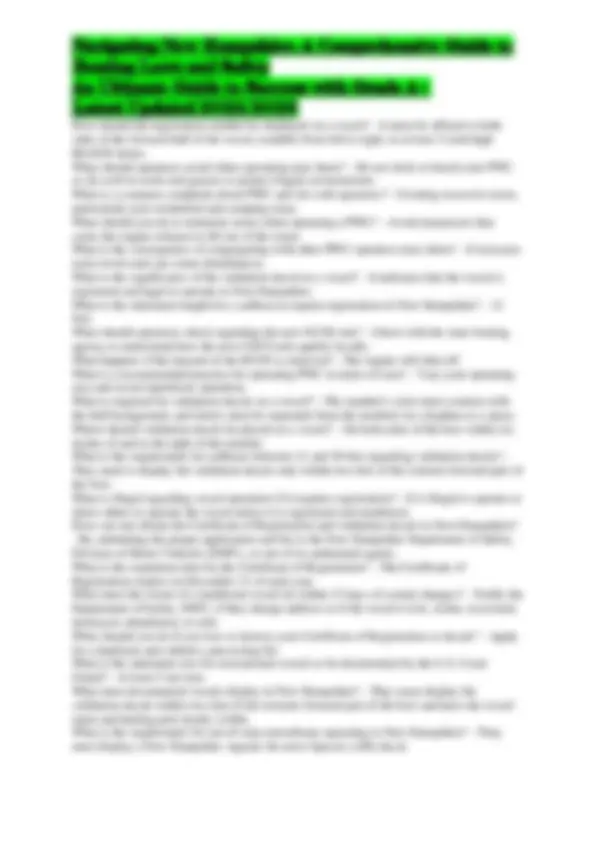
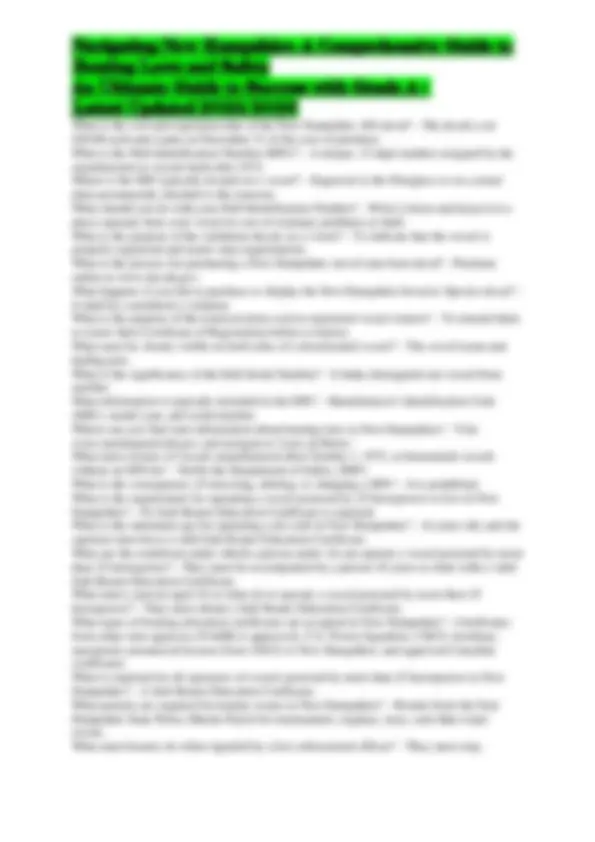
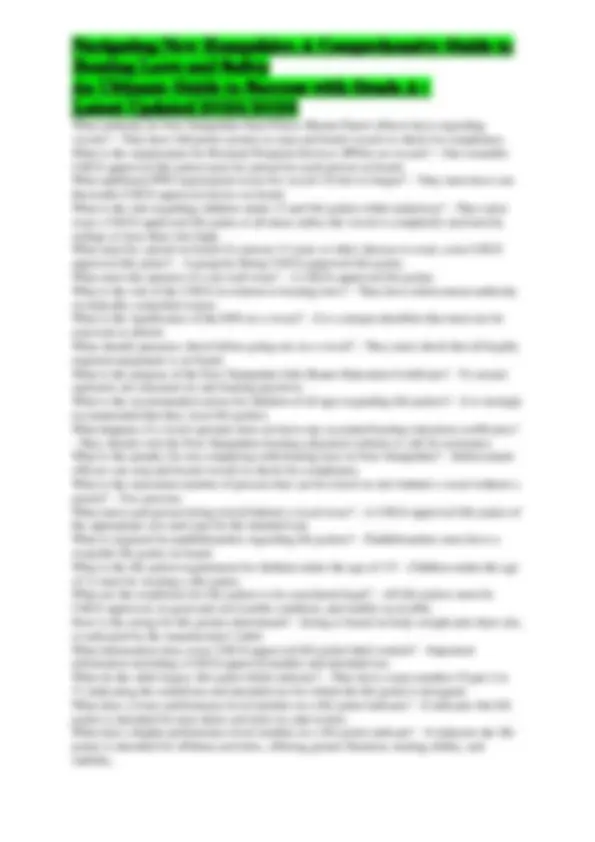

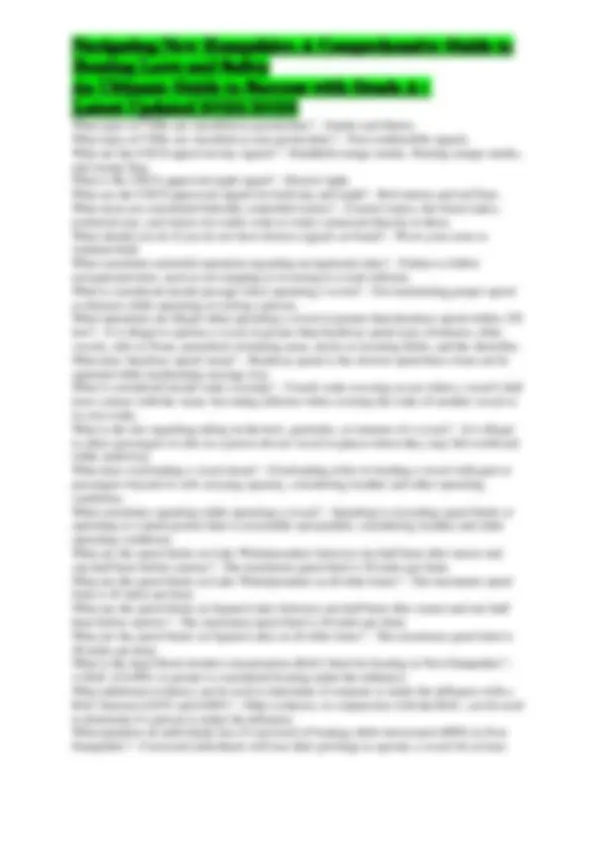
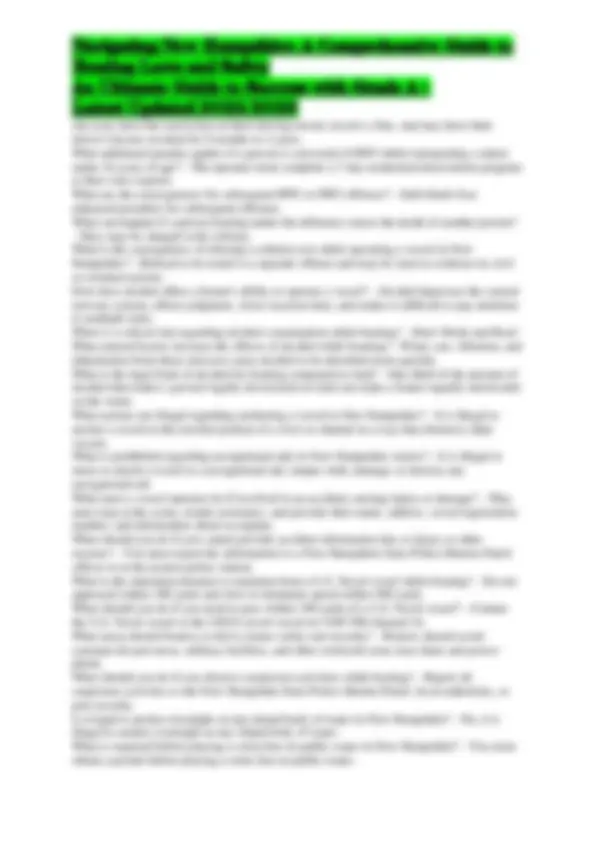
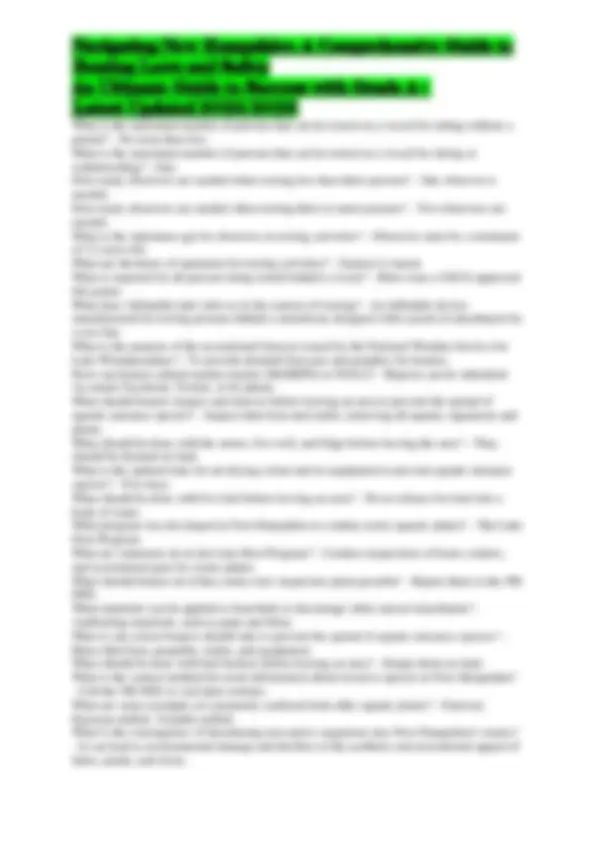
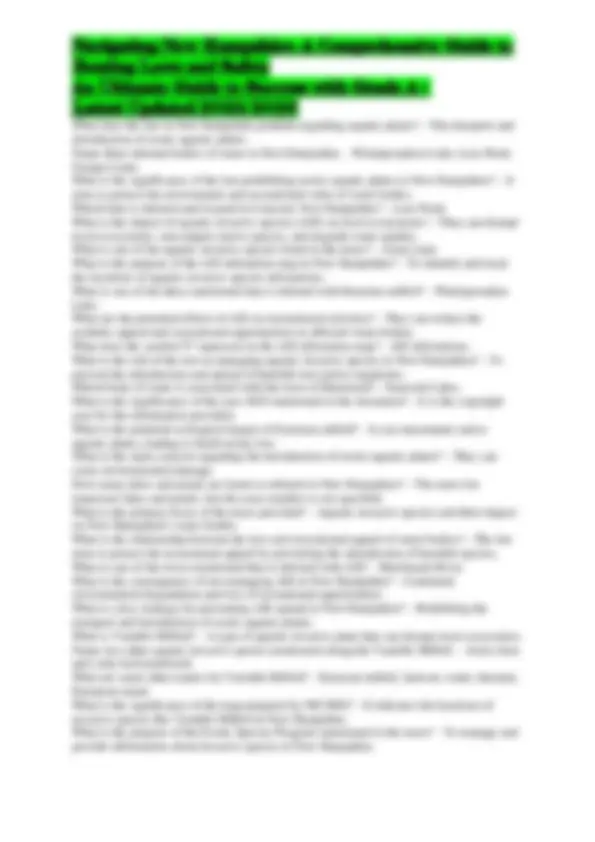
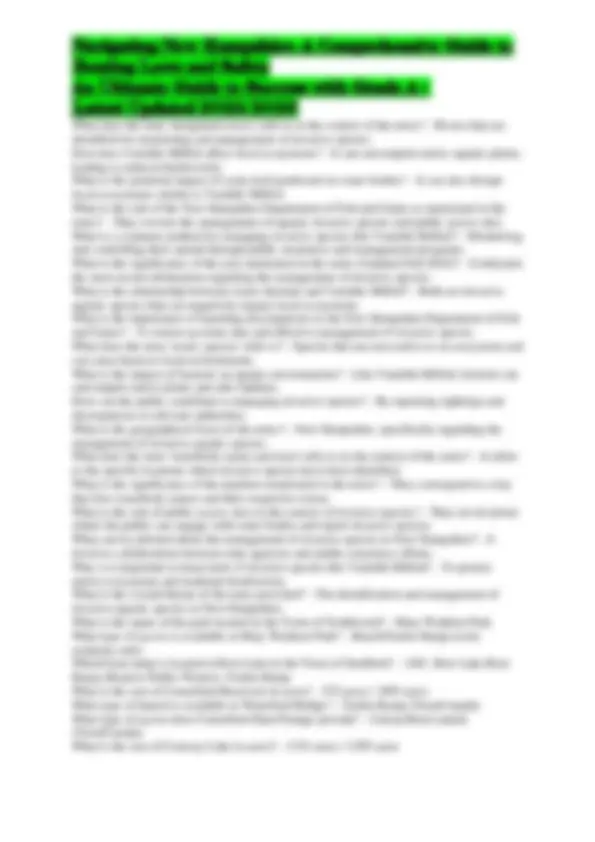
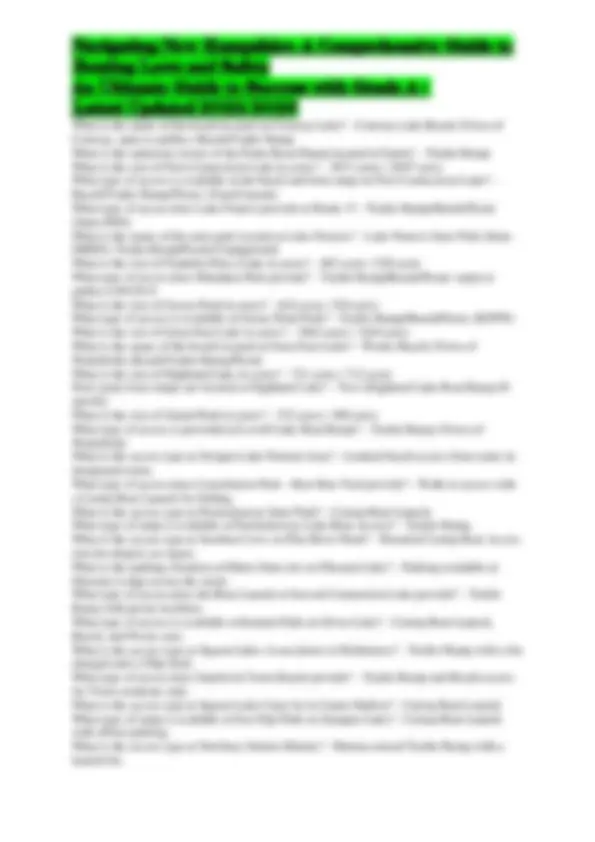
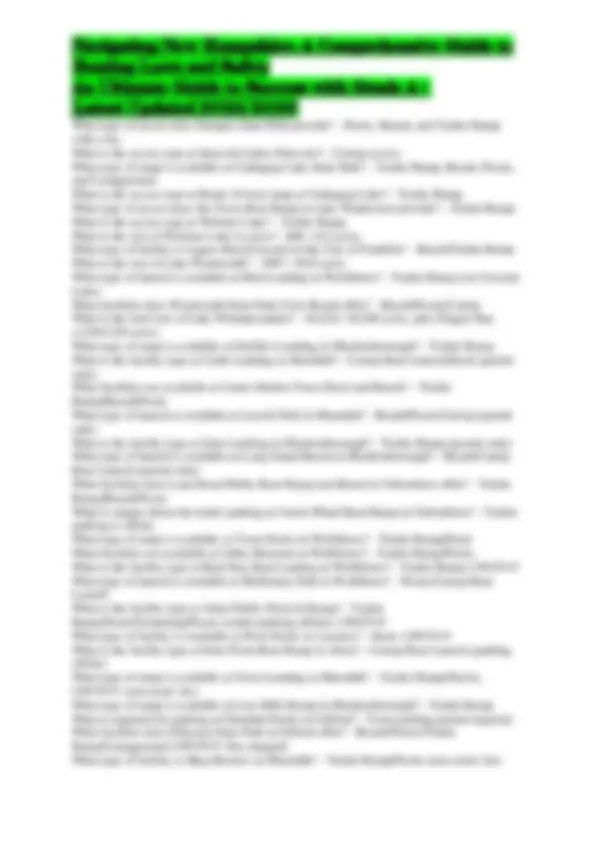



Study with the several resources on Docsity

Earn points by helping other students or get them with a premium plan


Prepare for your exams
Study with the several resources on Docsity

Earn points to download
Earn points by helping other students or get them with a premium plan
Community
Ask the community for help and clear up your study doubts
Discover the best universities in your country according to Docsity users
Free resources
Download our free guides on studying techniques, anxiety management strategies, and thesis advice from Docsity tutors
Navigating New Hampshire: A Comprehensive Guide to Boating Laws and Safety An Ultimate Guide to Success with Grade A+ Latest Updated 2025/2026
Typology: Exams
1 / 23

This page cannot be seen from the preview
Don't miss anything!
















What organization is responsible for the safety education of New Hampshire boaters? - The Department of Safety's State Police. What is the name of the safe boating program in New Hampshire? - Boat New Hampshire. What is required by law for many New Hampshire boaters? - Boating safety certification. What are the two ways to obtain boating safety certification in New Hampshire? - In a classroom or over the Internet. What is the benefit of completing the Boat New Hampshire safe boating program? - Many insurance companies offer a discount for successful completion. Where can you find the Marine Patrol Boating Education class schedule? - On the New Hampshire State Police website. What can you do online to become a certified boat operator in New Hampshire? - Complete the study course and pass the online exam. What is required after completing the online exam for boating certification? - You must take the final proctored exam required by New Hampshire law. What is the website for the online boating education course in New Hampshire? - www.boatingeducation.nh.gov. What does the publication state about the accuracy of its information? - Effort has been made to make it complete and accurate, but Kalkomey Enterprises, LLC is not liable for any claims or damages. What is the purpose of the U.S. Aids to Navigation System (ATON)? - To provide guidance for safe navigation on the water. What should you do before going out on the water? - Register your vessel and understand vessel length classes and capacity. What is the importance of filing a float plan? - It helps ensure safety by informing others of your boating plans. What is the significance of the Engine Cut-Off Switch (ECOS)? - It enhances safety by stopping the engine if the operator is thrown from the vessel. What are some unlawful operations on the water? - Alcohol and drug use, obstructing navigation. What is required for a vessel's hull identification? - A Hull Identification Number (HIN) must be displayed. What are Diver-Down Flags used for? - To indicate the presence of divers in the water. What are the consequences of discharging oil and hazardous substances? - It is illegal and can lead to penalties. What should boaters know about nighttime navigation? - They must follow specific navigation rules to ensure safety. What are the environmental considerations for boaters? - Boaters must be aware of their impact on the environment and follow regulations. What is the role of marine permits? - They regulate various activities on the water to ensure safety and compliance. What is the purpose of the enforcement section in the boating laws? - To outline the responsibilities of law enforcement in ensuring compliance with boating regulations. What is defined as 'ski craft' under New Hampshire law? - Any motorized vessel that is less than 13 feet in length, capable of exceeding 20 miles per hour, and has the capacity to carry no more than an operator and one other person. What should you do before going out on the water? - Take steps to make the outing safe and enjoyable.
How are vessels categorized in terms of length classes? - Vessels are divided into length classes: less than 16 feet, 16 feet to less than 26 feet, 26 feet to less than 40 feet, and 40 feet to less than 65 feet. How is vessel length measured? - From the tip of the bow in a straight line to the stern, excluding outboard motors, brackets, rudders, bow attachments, or swim platforms and ladders that are not molded parts of the hull. What is the purpose of a vessel's capacity plate? - It indicates the maximum weight capacity and maximum number of people that the vessel can carry safely. Are personal watercraft (PWC) required to have a capacity plate? - No, PWC and some other vessels are not required to have a capacity plate. What should you do before fueling a vessel? - Dock the boat securely, ask all passengers to exit, and ensure no one is smoking or striking a match. What precautions should be taken before fueling a vessel? - Check all fuel lines, connections, and fuel vents; turn off anything that might cause a spark; shut off all fuel valves; and extinguish all open flames. What is the recommended action if you must refuel at night? - Only refuel if it is an emergency, use electric lights, and try to refuel away from the water or on a commercial fueling ramp. What are the requirements for towing skiers, wakeboarders, and tubers? - Specific requirements apply for boaters who tow these activities, as outlined in New Hampshire laws. What are the consequences of discharging oil and other hazardous substances? - It is regulated and can result in penalties for non-compliance. What are the requirements for personal flotation devices (PFDs)? - PFDs must be available and in good condition for all passengers on board. What is the purpose of navigation lights on a vessel? - To ensure visibility and safety during nighttime or low visibility conditions. What is the function of fire extinguishers on a vessel? - To provide a means of combating small fires that may occur on board. What do backfire flame arrestors do? - They prevent flames from traveling back into the engine compartment, enhancing safety. What are sound-producing devices used for on a vessel? - To signal other vessels or communicate in situations where visibility is low. What are visual distress signals (VDSs)? - Signals used to indicate distress and request assistance from other vessels. What is the significance of the Lake Winnipesaukee forecast? - It provides important weather information for boaters operating in that area. What are aquatic nuisance species? - Non-native species that can disrupt local ecosystems and are regulated to prevent their spread. What should boaters do regarding overnight anchoring and mooring permits? - They must comply with local regulations and obtain necessary permits. What is the importance of the required equipment checklist? - To ensure that all necessary safety equipment is on board before heading out. What is the role of the New Hampshire Department of Safety, Marine Patrol Bureau? - To oversee boating laws and regulations in New Hampshire. What should you do before fueling your boat? - Close all windows, ports, doors, and other openings to prevent fumes from entering the boat.
When operating a power-driven vessel, to whom must you give way? - 1. Any vessel not under command. 2. Any vessel restricted in its ability to maneuver. 3. A vessel engaged in commercial fishing. 4. A sailboat under sail unless overtaking. When operating a vessel under sail, to whom must you give way? - 1. Any vessel not under command. 2. Any vessel restricted in its ability to maneuver. 3. A vessel engaged in commercial fishing. 4. Any vessel you are overtaking. What is a stand-on vessel? - The vessel that should maintain its course and speed. What is a give-way vessel? - The vessel that must take early and substantial action to avoid collision by stopping, slowing down, or changing course. In a head-on meeting between two power vessels, what should both vessels do? - Both vessels should keep to the starboard (right) side. In crossing situations between two power vessels, which vessel is the give-way vessel? - The vessel on the operator's port (left) side. In overtaking situations between two power vessels, which vessel is the stand-on vessel? - The vessel being overtaken. What should you be on the lookout for when boating at night? - The lights of other vessels. What are sidelights and what do they indicate? - Sidelights are red and green lights visible to another vessel approaching from the side or head-on; red indicates port (left) and green indicates starboard (right). What is a sternlight? - A white light seen from behind or nearly behind the vessel. What is a masthead light and when is it required? - A white light that shines forward and to both sides, required on all power-driven vessels when under engine power. What is an all-round white light and when can it be used? - On power-driven vessels less than 39.4 feet, it combines a masthead light and sternlight into a single white light visible from any direction, serving as an anchor light when sidelights are extinguished. What does a masthead light indicate and what is its range? - A masthead light indicates a vessel's presence and has a range of 225 degrees. What does an all-round white light signify? - An all-round white light signifies a vessel that is visible from all directions (360 degrees). What are sidelights and what do they indicate? - Sidelights are combination lights that indicate a vessel's port (red) and starboard (green) sides. What is the purpose of a sternlight? - A sternlight indicates the rear of a vessel. What should you do when you see only a white light from another vessel? - You are overtaking another vessel, which is the stand-on vessel; you may go around it on either side. What does it mean if you see a green and a white light? - You are the stand-on vessel, but remain alert as the other vessel may not see you. What action is required when you see a red and a white light? - You must give way to the other vessel, either slowing down or passing behind it. What should you do when you see only a red light or only a green light? - You may be approaching a sailboat under sail, which is always the stand-on vessel; you must give way. What are lateral markers in the U.S. Aids to Navigation System (ATON)? - Lateral markers indicate the edges of safe water areas and use a combination of colors and numbers. What do red colors, lights, and even numbers signify in lateral markers? - They indicate the right side of the channel as a boater enters from the open sea or heads upstream. What do green colors, lights, and odd numbers signify in lateral markers? - They indicate the left side of the channel as a boater enters from the open sea or heads upstream.
What does the 'Red Right Returning' rule remind boaters? - It reminds boaters to keep red markers on their right when returning from open waters or heading upstream. What are nuns in the context of boating? - Nuns are red cone-shaped buoys marked with even numbers. What are cans in the context of boating? - Cans are green cylindrical-shaped buoys marked with odd numbers. What are lighted buoys? - Lighted buoys use lateral marker colors and numbers, and have a matching colored light. What are daymarks? - Daymarks are permanently placed signs in the water, such as red triangles (nuns) and green squares (cans), which may also be lighted. What do regulatory markers indicate? - Regulatory markers are white with orange markings and black lettering, providing information about rules and regulations. What do square regulatory markers indicate? - Squares indicate locations for food, supplies, repairs, and provide directions. What do circular regulatory markers indicate? - Circles indicate controlled areas such as speed limits or no fishing zones. What do crossed diamond markers signify? - Crossed diamonds indicate areas that are off- limits to all vessels. What do diamond markers warn about? - Diamonds warn of dangers such as rocks, shoals, construction, dams, or stumps. What are safe water markers? - Safe water markers are white with red vertical stripes and mark mid-channels or fairways, which may be passed on either side. What do Inland Waters Obstruction Markers indicate? - They indicate an obstruction to navigation. What color are Inland Waters Obstruction Markers? - White with black vertical stripes. What should you not do when near Inland Waters Obstruction Markers? - Do not pass between these buoys and the nearest shore. What does an all black spar buoy mark? - It marks one side of a well-defined channel. What does an all red spar buoy mark? - It marks the opposite side of a well-defined channel from the all black buoy. What should you do when heading east or west and encountering a white buoy with a red top? - Go south of this buoy. What should you do when heading north or south and encountering a white buoy with a red top? - Go west of this buoy. What should you do when heading east or west and encountering a white buoy with a black top? - Go north of this buoy. What should you do when heading north or south and encountering a white buoy with a black top? - Go east of this buoy. What should you do to prepare your boat for severe weather? - Slow down, close all hatches, stow unnecessary gear, turn on navigation lights, and keep bilges free of water. What should passengers do if caught in severe weather? - Put on a U.S. Coast Guard approved life jacket and sit on the vessel floor close to the centerline. What is the best course of action if you can safely approach shore during a storm? - Head for the nearest shore that is safe to approach. What should you do if you are caught in a storm and cannot safely approach shore? - Ride it out in open water.
What is the importance of maintaining power on a PWC or jet-propelled vessel? - Power is necessary to maintain steering control. What should you wear to protect against hypothermia while boating in cold water? - Dress in layers under your life jacket or wear a wetsuit or drysuit. What should you do if you are not wearing a life jacket and fall into cold water? - Look for a flotation device or other buoyant items. What is the best position to maintain body heat in cold water? - Draw your knees to your chest and arms to your sides. What should you do to help others in the water with you? - Huddle together with your arms around their shoulders. What is the recommended action if you are boating in rough weather? - Avoid boating in rough water or bad weather. Why is it important to balance the load on a boat? - To reduce the risk of capsizing or swamping. What is a throwable device and when should it be used? - A throwable device is used to assist someone who has fallen overboard. What should you do if you are boating and notice symptoms of hypothermia in yourself or others? - Take immediate action to get warm and seek help. What is a key feature of new Personal Watercraft (PWC) regarding steering? - New PWCs allow for off-throttle steering. What should operators remember about stopping a PWC? - Most PWCs do not have brakes, and stopping takes time even after releasing the throttle or shutting off the engine. What is the purpose of the Emergency Engine Cut-Off Switch (ECOS) on PWCs? - The ECOS is designed to shut the engine down if the operator is thrown from the proper operating position. What is required by the USCG and New Hampshire regarding the use of ECOS? - Operators must use the ECOS at all times when operating vessels equipped with this device. How does the ECOS function? - It works by attaching a lanyard between the operator and the switch; if the lanyard is removed, the engine shuts off. What should you do if your PWC does not have an ECOS? - You should have one installed. What new law regarding ECOS will take effect in August 2024? - Operators of recreational vessels less than 26 feet must use the ECOS when the vessel is operating on plane or above headway speed. What should operators avoid doing near other vessels? - Operators should not jump the wake of a passing vessel or ride too close, as this creates risks and is illegal. What are some environmental considerations for PWC operation? - Avoid excessive noise, operating in shallow water, and creating wakes that can cause erosion. What should you do when fueling your PWC or ski craft? - Take extra care and fuel on land if possible. What is required for operating a vessel legally in New Hampshire? - You must have a New Hampshire Certificate of Registration and validation decals. Which vessels are exempt from needing a New Hampshire Certificate of Registration? - Sailboats under 12 feet, small non-motorized vessels like canoes and kayaks, vessels registered in other states using NH waters for 30 days or fewer, and U.S. government vessels. What must be done with the Certificate of Registration while operating a vessel? - It must be on board and available for inspection by an enforcement officer.
How should the registration number be displayed on a vessel? - It must be affixed to both sides of the forward half of the vessel, readable from left to right, in at least 3-inch-high BLOCK letters. What should operators avoid when operating near shore? - Do not dock or beach your PWC or ski craft in reeds and grasses to protect fragile environments. What is a common complaint about PWC and ski craft operators? - Creating excessive noise, particularly near residential and camping areas. What should you do to minimize noise when operating a PWC? - Avoid maneuvers that cause the engine exhaust to lift out of the water. What is the consequence of congregating with other PWC operators near shore? - It increases noise levels and can create disturbances. What is the significance of the validation decal on a vessel? - It indicates that the vessel is registered and legal to operate in New Hampshire. What is the minimum length for a sailboat to require registration in New Hampshire? - 12 feet. What should operators check regarding the new ECOS rule? - Check with the state boating agency to understand how the new USCG rule applies locally. What happens if the lanyard of the ECOS is removed? - The engine will shut off. What is a recommended practice for operating PWC in terms of area? - Vary your operating area and avoid repetitious operation. What is required for validation decals on a vessel? - The number's color must contrast with the hull background, and letters must be separated from the numbers by a hyphen or a space. Where should validation decals be placed on a vessel? - On both sides of the bow within six inches of and to the right of the number. What is the requirement for sailboats between 12 and 20 feet regarding validation decals? - They need to display the validation decals only within two feet of the extreme forward part of the bow. What is illegal regarding vessel operation if it requires registration? - It is illegal to operate or allow others to operate the vessel unless it is registered and numbered. How can one obtain the Certificate of Registration and validation decals in New Hampshire?
What authority do New Hampshire State Police-Marine Patrol officers have regarding vessels? - They have full police powers to stop and board vessels to check for compliance. What is the requirement for Personal Flotation Devices (PFDs) on vessels? - One wearable USCG-approved life jacket must be carried for each person on board. What additional PFD requirement exists for vessels 16 feet or longer? - They must have one throwable USCG-approved device on board. What is the rule regarding children under 13 and life jackets while underway? - They must wear a USCG-approved life jacket at all times unless the vessel is completely enclosed by railings at least three feet high. What must be carried on board if a person 13 years or older chooses to wear a non-USCG approved life jacket? - A properly fitting USCG-approved life jacket. What must the operator of a ski craft wear? - A USCG-approved life jacket. What is the role of the USCG in relation to boating laws? - They have enforcement authority on federally controlled waters. What is the significance of the HIN on a vessel? - It is a unique identifier that must not be removed or altered. What should operators check before going out on a vessel? - They must check that all legally required equipment is on board. What is the purpose of the New Hampshire Safe Boater Education Certificate? - To ensure operators are educated on safe boating practices. What is the recommended action for children of all ages regarding life jackets? - It is strongly recommended that they wear life jackets. What happens if a vessel operator does not have any accepted boating education certificates?
What should be tested before using a life jacket? - Whether the life jacket will turn an unconscious person face up. What navigation lights are required for power-driven vessels less than 65.6 feet long? - Red and green sidelights visible from at least two miles away, and an all-round white light or both a masthead light and a sternlight. What is the visibility requirement for sidelights on vessels less than 39.4 feet long? - Sidelights must be visible from at least one mile away on a dark, clear night. What lights must unpowered vessels exhibit if less than 65.6 feet long? - Red and green sidelights visible from at least two miles away and a sternlight visible from at least two miles away. What should unpowered vessels less than 23.0 feet long do regarding navigation lights? - They should exhibit the same lights as required for unpowered vessels less than 65.6 feet if practical, or have a 360-degree white light visible all around the horizon for a distance of two miles. What is the purpose of navigation lights displayed on vessels? - To ensure visibility between sunset and sunrise and during periods of restricted visibility. What is the minimum height requirement for the all-round white light compared to sidelights? - The all-round white light (or the masthead light) must be at least 3.3 feet higher than the sidelights. What are the conditions under which a life jacket is not approved for certain activities? - Some life jackets are not approved for water-skiing, PWC or wakeboarding, and tubing. What is the legal requirement for life jackets regarding their condition? - Life jackets must be in good and serviceable condition. What does the USCG approval number on a life jacket signify? - It signifies that the life jacket meets legal requirements for safety. What is the significance of the performance level icon on new life jacket labels? - It indicates the intended use and performance capabilities of the life jacket. What must be done with life jackets that have legacy labels? - They may still be used if they are in serviceable condition. What is the visibility requirement for the all-round white light on vessels less than 39.4 feet long? - It must be visible from a distance of at least two miles on a dark, clear night. What type of vessels are considered unpowered? - Sailboats or vessels that are paddled, poled, or rowed. What type of light must all vessels use when moored or anchored away from dock at night? - A white light visible for 360 degrees and from a distance of two miles. What is the requirement for power-driven vessels less than 39.4 feet long regarding lights? - The masthead light and sternlight may be combined as an all-round white light. What lighting alternative is allowed for unpowered vessels less than 65.6 feet? - A combination red, green, and white light exhibited near the top of the mast. What is prohibited regarding shoreline lights visible from the water? - No person shall display lights that resemble the required navigation lights of any vessel. What is the effective date for the removal of non-rechargeable fire extinguishers older than 12 years? - April 20, 2022. What type of fire extinguisher is required on all vessels with an inboard engine? - A Type B USCG-approved fire extinguisher.
What are the noise level limits for motorized vessels manufactured on or after January 1, 1991? - 8 8 decibels stationary test limit and 82 decibels moving test limit. What is required for vessels less than 16 feet long under engine power on state waters? - A hand, mouth, or power whistle audible for one-half mile. What sound-producing device is required for vessels 16 to less than 26 feet long under engine power on state waters? - A hand or power whistle audible for one mile. What sound-producing device is required for vessels 40 feet long or longer under engine power on state waters? - A power whistle audible for one mile. What sound-producing device is required for vessels less than 39.4 feet long on federally controlled waters? - A handheld air horn, athletic whistle, installed horn, or other efficient sound signal. What sound-producing device is required for vessels 39.4 feet long or longer on federally controlled waters? - A sound-producing device audible for one-half mile and lasting 4 to 6 seconds. What should recreational boaters be familiar with regarding sound signals? - Common sound signals used to communicate intentions or position. What does one short blast indicate when boating? - It indicates the intention to pass on the port (left) side. What does two short blasts indicate when boating? - It indicates the intention to pass on the starboard (right) side. What does three short blasts indicate when boating? - It indicates operating astern propulsion or backing up. What signal do power-driven vessels use when underway under restricted visibility? - One prolonged blast at intervals of not more than two minutes. What signal do sailboats use when under sail alone in restricted visibility? - One prolonged blast plus two short blasts at intervals of not more than two minutes. What is the purpose of one prolonged blast as a warning signal? - It is used when coming around a blind bend or exiting a slip. What do five or more short rapid blasts signal? - They signal danger or indicate disagreement with another boater's intentions. What are Visual Distress Signals (VDSs)? - Signals that allow vessel operators to signal for help in an emergency. What must vessels on federally controlled waters be equipped with regarding VDSs? - They must have USCG approved VDSs that are in serviceable condition, readily accessible, and not expired. What is required for all vessels operating between sunset and sunrise? - They must carry night signals. Which vessels are exempt from carrying day signals? - Recreational vessels less than 16 feet, non-motorized open sailboats less than 26 feet, and manually propelled vessels. What is the minimum requirement for carrying pyrotechnic VDSs? - A minimum of three unexpired VDSs must be carried on board. What are examples of VDSs that satisfy USCG requirements? - Three handheld red flares, one handheld red flare and two red meteors, or one handheld orange smoke signal and two floating orange smoke signals. When is it prohibited to display VDSs while on the water? - It is prohibited unless assistance is required to prevent immediate or potential danger. How are VDSs classified? - As day signals, night signals, or both day and night signals.
What types of VDSs are classified as pyrotechnic? - Smoke and flames. What types of VDSs are classified as non-pyrotechnic? - Non-combustible signals. What are the USCG-approved day signals? - Handheld orange smoke, floating orange smoke, and orange flag. What is the USCG-approved night signal? - Electric light. What are the USCG-approved signals for both day and night? - Red meteor and red flare. What areas are considered federally controlled waters? - Coastal waters, the Great Lakes, territorial seas, and waters two miles wide or wider connected directly to these. What should you do if you do not have distress signals on board? - Wave your arms to summon help. What constitutes unlawful operation regarding navigational rules? - Failure to follow navigational rules, such as not stopping or reversing to avoid collision. What is considered unsafe passage when operating a vessel? - Not maintaining proper speed or distance while operating or towing a person. What operations are illegal when operating a vessel at greater than headway speed within 150 feet? - It is illegal to operate a vessel at greater than headway speed near swimmers, other vessels, rafts or floats, permitted swimming areas, docks or mooring fields, and the shoreline. What does 'headway speed' mean? - Headway speed is the slowest speed that a boat can be operated while maintaining steerage way. What is considered unsafe wake crossing? - Unsafe wake crossing occurs when a vessel's hull loses contact with the water, becoming airborne when crossing the wake of another vessel or its own wake. What is the law regarding riding on the bow, gunwales, or transom of a vessel? - It is illegal to allow passengers to ride on a power-driven vessel in places where they may fall overboard while underway. What does overloading a vessel mean? - Overloading refers to loading a vessel with gear or passengers beyond its safe carrying capacity, considering weather and other operating conditions. What constitutes speeding while operating a vessel? - Speeding is exceeding speed limits or operating at a speed greater than is reasonable and prudent, considering weather and other operating conditions. What are the speed limits on Lake Winnipesaukee between one-half hour after sunset and one-half hour before sunrise? - The maximum speed limit is 30 miles per hour. What are the speed limits on Lake Winnipesaukee at all other times? - The maximum speed limit is 45 miles per hour. What are the speed limits on Squam Lakes between one-half hour after sunset and one-half hour before sunrise? - The maximum speed limit is 20 miles per hour. What are the speed limits on Squam Lakes at all other times? - The maximum speed limit is 40 miles per hour. What is the legal blood alcohol concentration (BAC) limit for boating in New Hampshire? - A BAC of 0.08% or greater is considered boating under the influence. What additional evidence can be used to determine if someone is under the influence with a BAC between 0.03% and 0.08%? - Other evidence, in conjunction with the BAC, can be used to determine if a person is under the influence. What penalties do individuals face if convicted of boating while intoxicated (BWI) in New Hampshire? - Convicted individuals will lose their privilege to operate a vessel for at least
What is the responsibility of a vessel operator if they know they have been involved in an accident? - They must immediately stop, render assistance, and provide necessary information to others involved. What should you do if you see something unusual while boating? - Keep a sharp eye out and report anything that looks peculiar or out of the ordinary. What are the potential effects of alcohol on a boater's ability to track multiple vessels? - Alcohol makes it difficult to keep track of two or more vessels, which is critical in emergency situations. What is the effect of dehydration on alcohol absorption while boating? - Dehydration from natural stressors causes alcohol to be absorbed into the system more quickly. What must you do if you cut loose a moored vessel without permission? - It is illegal to cut loose any vessel that is moored or at anchor without the owner's permission. What is the consequence of obstructing a pier, wharf, or boat ramp? - It is illegal to obstruct a pier, wharf, boat ramp, or access to any facility. What should you do if you are unable to provide accident information due to an injured person's condition? - Report the information to a police officer when they arrive at the scene or notify the nearest police station. How does alcohol affect a person's reaction time while boating? - Alcohol slows reaction time, making it harder to respond quickly in emergency situations. What must a person operating a vessel involved in an accident do immediately? - Report the accident to law enforcement and submit a written accident report to the New Hampshire State Police-Marine Patrol Bureau within 15 days. Under what conditions is a written accident report required in New Hampshire? - When anyone is injured or killed, or if property damage exceeds $2,000. What is the consequence of failing to file an accident report in New Hampshire? - It is a Class A misdemeanor. What is the consequence of providing false information about an accident in New Hampshire? - It is a Class B felony. What must scuba divers or snorkelers display according to state law? - A diver-down flag to mark the diving area. What is the required distance that divers and snorkelers must stay from their diver-down flag?
What must a vessel have if it is on inland waters and has a toilet? - A holding tank with no through-hull discharge option. What type of marine sanitation device (MSD) must a recreational vessel with installed toilet facilities have? - An operable marine sanitation device (MSD) that is USCG certified. What are Types I and II MSDs? - Devices that treat waste with chemicals to kill bacteria before discharge, allowed only on marine waters. What is a Type III MSD? - A holding tank or portable toilet that provides no treatment; waste must be disposed of at an onshore pump-out station. What is illegal regarding trash disposal in New Hampshire waters? - It is illegal to dump refuse, garbage, or plastics into state or federally controlled waters. What must be done with trash on board a vessel? - Store it in a container and place it in a proper receptacle after returning to shore. What is the minimum size for a vessel to require a Garbage Disposal Placard on federally controlled waters? - 26 feet or longer. What are the dimensions of the Garbage Disposal Placard that must be displayed? - At least 4 x 9 inches. How does New Hampshire law define a 'ski craft'? - A motorized vessel that is less than 13 feet in length, capable of exceeding 20 miles per hour, and carries no more than an operator and one other person. What is the minimum age requirement to legally operate a 'ski craft' in New Hampshire? - No one under the age of 16 years. What type of life jacket must the operator of a 'ski craft' wear at all times? - A USCG- approved life jacket. During what hours may 'ski craft' be operated on lakes, ponds, rivers, or coastal waters? - Only during daylight hours (sunrise to sunset). What is the maximum speed allowed for 'ski craft' within 150 feet of swimmers, other vessels, rafts, or docks? - Headway speed. What is the restriction on operating a 'ski craft' within a cove? - It is illegal to operate within a cove or within 300 feet of shore unless proceeding at headway speed to an area where operation is permitted. What are some illegal activities when operating a 'ski craft'? - Weaving through congested traffic, getting dangerously close to another vessel or person, and operating in a careless or negligent way. On what type of water bodies is the operation of 'ski craft' prohibited? - On any pond or lake less than 75 acres in area. What is recommended for operators of PWCs equipped with a lanyard-type engine cut-off switch (ECOS)? - To attach the lanyard to their person, clothing, or life jacket. What should you ensure about someone before allowing them to operate your 'ski craft' or PWC? - They meet age and education requirements and understand basic boating safety and navigation rules. What should you demonstrate to new operators of a PWC? - How to start and reboard the PWC while on shore or in shallow water. What is crucial for steering control on most PWCs? - Power is required for steering control. What should an operator understand about the ECOS before starting the engine? - How to use the ECOS and attach the lanyard to their person or life jacket. What should operators recognize when approaching a 'slow, no wake' speed marker? - They should know how to recognize the marker and what to do when approaching one.
What does the law in New Hampshire prohibit regarding aquatic plants? - The transport and introduction of exotic aquatic plants. Name three infested bodies of water in New Hampshire. - Winnipesaukee Lake, Lees Pond, Ossipee Lake. What is the significance of the law prohibiting exotic aquatic plants in New Hampshire? - It aims to protect the environment and recreational value of water bodies. Which lake is infested and located in Concord, New Hampshire? - Lees Pond. What is the impact of aquatic invasive species (AIS) on local ecosystems? - They can disrupt local ecosystems, outcompete native species, and degrade water quality. What is one of the aquatic invasive species listed in the notes? - Asian clam. What is the purpose of the AIS infestation map in New Hampshire? - To identify and track the locations of aquatic invasive species infestations. What is one of the lakes mentioned that is infested with Eurasian milfoil? - Winnipesaukee Lake. What are the potential effects of AIS on recreational activities? - They can reduce the aesthetic appeal and recreational opportunities in affected water bodies. What does the symbol 'Ü' represent on the AIS infestation map? - AIS infestations. What is the role of the law in managing aquatic invasive species in New Hampshire? - To prevent the introduction and spread of harmful non-native organisms. Which body of water is associated with the town of Barnstead? - Suncook Lakes. What is the significance of the year 2025 mentioned in the document? - It is the copyright year for the information provided. What is the potential ecological impact of Eurasian milfoil? - It can outcompete native aquatic plants, leading to biodiversity loss. What is the main concern regarding the introduction of exotic aquatic plants? - They can cause environmental damage. How many lakes and ponds are listed as infested in New Hampshire? - The notes list numerous lakes and ponds, but the exact number is not specified. What is the primary focus of the notes provided? - Aquatic invasive species and their impact on New Hampshire's water bodies. What is the relationship between the law and recreational appeal of water bodies? - The law aims to protect the recreational appeal by preventing the introduction of harmful species. What is one of the rivers mentioned that is infested with AIS? - Merrimack River. What is the consequence of not managing AIS in New Hampshire? - Continued environmental degradation and loss of recreational opportunities. What is a key strategy for preventing AIS spread in New Hampshire? - Prohibiting the transport and introduction of exotic aquatic plants. What is Variable Milfoil? - A type of aquatic invasive plant that can disrupt local ecosystems. Name two other aquatic invasive species mentioned alongside Variable Milfoil. - Asian clam and curly-leaf pondweed. What are some other names for Variable Milfoil? - Eurasian milfoil, fanwort, water chestnut, European naiad. What is the significance of the map prepared by NH DES? - It indicates the locations of invasive species like Variable Milfoil in New Hampshire. What is the purpose of the Exotic Species Program mentioned in the notes? - To manage and provide information about invasive species in New Hampshire.
What does the term 'designated rivers' refer to in the context of the notes? - Rivers that are identified for monitoring and management of invasive species. How does Variable Milfoil affect local ecosystems? - It can outcompete native aquatic plants, leading to reduced biodiversity. What is the potential impact of curly-leaf pondweed on water bodies? - It can also disrupt local ecosystems similar to Variable Milfoil. What is the role of the New Hampshire Department of Fish and Game as mentioned in the notes? - They oversee the management of aquatic invasive species and public access sites. What is a common method for managing invasive species like Variable Milfoil? - Monitoring and controlling their spread through public awareness and management programs. What is the significance of the year mentioned in the notes (Updated Fall 2024)? - It indicates the most recent information regarding the management of invasive species. What is the relationship between water chestnut and Variable Milfoil? - Both are invasive aquatic species that can negatively impact local ecosystems. What is the importance of reporting discrepancies to the New Hampshire Department of Fish and Game? - To ensure accurate data and effective management of invasive species. What does the term 'exotic species' refer to? - Species that are non-native to an ecosystem and can cause harm to local environments. What is the impact of fanwort on aquatic environments? - Like Variable Milfoil, fanwort can outcompete native plants and alter habitats. How can the public contribute to managing invasive species? - By reporting sightings and discrepancies to relevant authorities. What is the geographical focus of the notes? - New Hampshire, specifically regarding the management of invasive aquatic species. What does the term 'waterbody name and town' refer to in the context of the notes? - It refers to the specific locations where invasive species have been identified. What is the significance of the numbers mentioned in the notes? - They correspond to a key that lists waterbody names and their respective towns. What is the role of public access sites in the context of invasive species? - They are locations where the public can engage with water bodies and report invasive species. What can be inferred about the management of invasive species in New Hampshire? - It involves collaboration between state agencies and public awareness efforts. Why is it important to keep track of invasive species like Variable Milfoil? - To protect native ecosystems and maintain biodiversity. What is the overall theme of the notes provided? - The identification and management of invasive aquatic species in New Hampshire. What is the name of the park located in the Town of Northwood? - Mary Waldron Park What type of access is available at Mary Waldron Park? - Beach/Trailer Ramp (town residents only) Which boat ramp is located at Bow Lake in the Town of Strafford? - 1481. Bow Lake Boat Ramp (Road to Public Waters); Trailer Ramp What is the size of Comerford Reservoir in acres? - 535 acres / 1093 acres What type of launch is available at Waterford Bridge? - Trailer Ramp (TransCanada) What type of access does Comerford Dam Portage provide? - Cartop Boat Launch (TransCanada) What is the size of Conway Lake in acres? - 1316 acres / 1299 acres